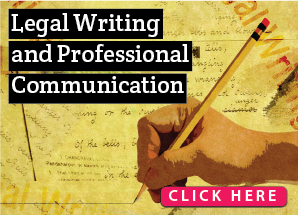 Last week’s post focused on how lawyers can enhance relationships with their clients using plain English communication. I raised the point that our clients often have a certain expectation about the kind of language lawyers should use, and how there needs to be explanation and education about the benefits of plain language. Those same expectations undoubtedly exist across the profession—amongst our colleagues and in the judiciary—so, to encourage the use of plain English, we also need to tackle those perceptions.
Last week’s post focused on how lawyers can enhance relationships with their clients using plain English communication. I raised the point that our clients often have a certain expectation about the kind of language lawyers should use, and how there needs to be explanation and education about the benefits of plain language. Those same expectations undoubtedly exist across the profession—amongst our colleagues and in the judiciary—so, to encourage the use of plain English, we also need to tackle those perceptions.
As we all know, one of the essential prerequisites of good communication is to know your audience. This is true across all forms of writing and speaking and is especially important when you are trying to persuade your reader or listener. As lawyers, when we are communicating with colleagues and judges, we are very often trying to persuade them to come around to our point of view.
So, what does this have to do with plain English? Well, the current belief amongst many lawyers is that the use of legalese is the only way to draft legal documents and to address the bench in court. But if we really think about the questions “who is my audience?” and, moreover, “what will appeal to them?”, we can see that the use of plain English is actually very helpful.
First of all, keep in mind that when I am advocating the use of plain English, it is not a suggestion that language should be simplistic or colourless. One of the first aspects of knowing your audience is knowing their level of education and understanding, how they might usually speak and write, and therefore how sophisticated your language can be. In the case of communicating with judges and fellow advocates you can, therefore, afford to use sophisticated language. But in doing so, you can also still stick to the tenets of clear, direct, and concise communication—plain English is not just about your vocabulary (although the words that you use are an important consideration), it is also about things like sentence construction and structure.
Make a positive impression with judges and colleagues
Once we’ve thought about the kind of language that we can employ with our audience, the second thing we need to think about is how to best engage or persuade them. As with any audience, in considering communication with other members of the profession, put yourself in their shoes. That should be relatively easy if you are already a lawyer yourself. Think about, for example, what characterises the professional life of a judge or an advocate in India? What difficulties do they face and what would, therefore, be most helpful to this audience and most likely to make a positive impression?
Obviously, the answers to those questions have to address the fact that Indian courts are massively over-burdened and judges must bear an almost impossible caseload. Advocates and lawyers, too, work very long hours and have many clients and cases to attend to. In such a scenario, I would suggest that the number one benefit of plain English is efficiency and ease of understanding.
Imagine the relief of a tired and busy lawyer or judge when they reach for the next motion, brief, or letter and find that it’s written clearly and well, and that they only have to read it once to appreciate the argument or message contained in it. In court, when there is certainly no time to waste, those who speak plainly, clearly, and well will impress the bench with the fact that they are able to get to the point and explain their matter succinctly. A lawyer can build a good reputation with such skills, and is considerably better placed to persuade effectively.
Finally, in case you think that I am merely relying on my own suppositions in making this argument, there has been research done in this area. A study was conducted through the School of Law at the University of Texas in the U.S. into whether judges prefer plain English, legalese, or informal writing. The results clearly demonstrated that judges overwhelmingly favoured the use of plain  English in legal writing, finding it to be clearer, more understandable, and ultimately, more persuasive— by a margin of two-thirds (See, Sean Flammer, “Persuading Judges: An Empirical Analysis of Writing Style, Persuasion, and the Use of Plain English”, The Journal of the Legal Writing Institute 16 (2010) at 183.). Given that these are all qualities that most lawyers aim for, this study demonstrates what is apparent to the finest lawyers in active practice—that good use of plain English is essential to effective communication and advocacy.
English in legal writing, finding it to be clearer, more understandable, and ultimately, more persuasive— by a margin of two-thirds (See, Sean Flammer, “Persuading Judges: An Empirical Analysis of Writing Style, Persuasion, and the Use of Plain English”, The Journal of the Legal Writing Institute 16 (2010) at 183.). Given that these are all qualities that most lawyers aim for, this study demonstrates what is apparent to the finest lawyers in active practice—that good use of plain English is essential to effective communication and advocacy.
(Tennille Duffy is part of the faculty at myLaw.net.)

